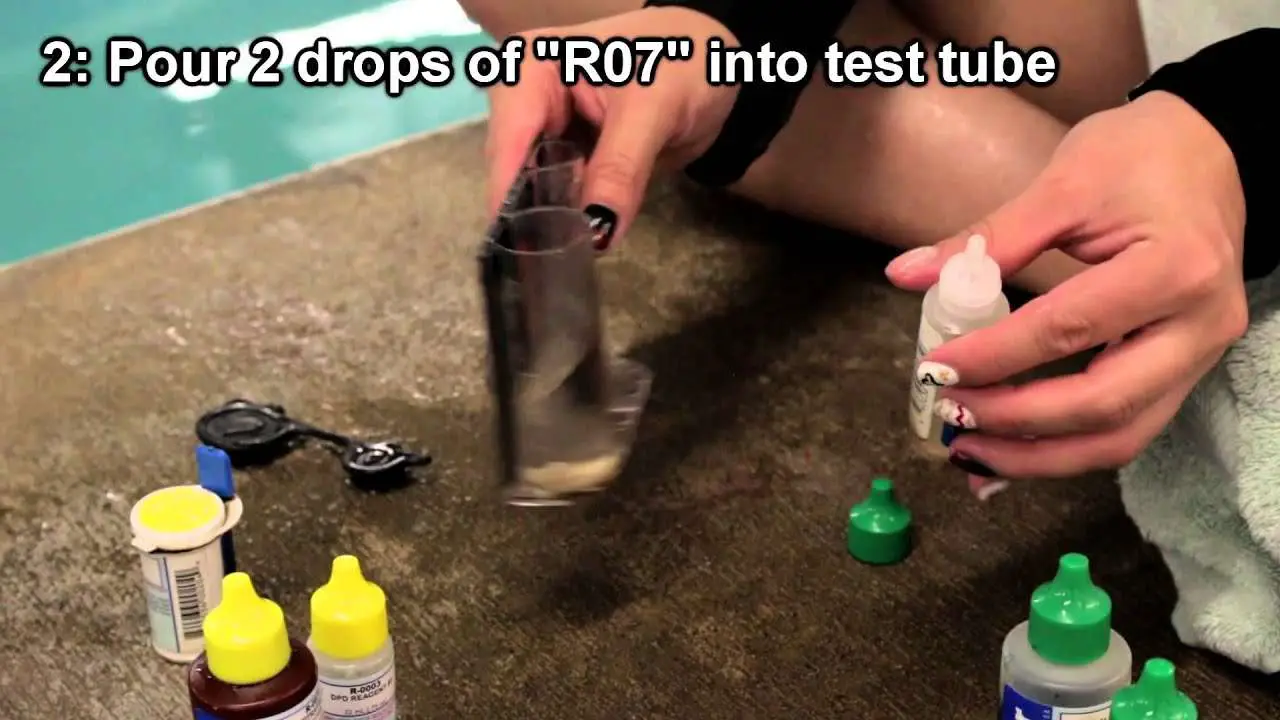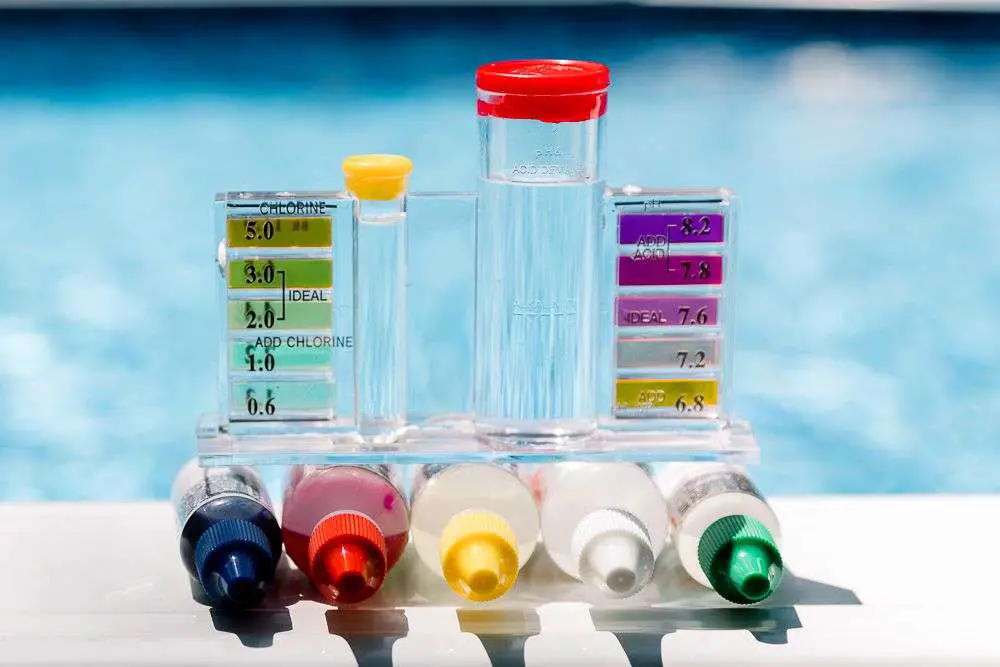S For Testing Your Pool Water
There are plenty of different ways you can test the chemicals in your pool, but what is essential is that you find a way that works for youhaving an improper balance of chemicals in the pool could either lead to algae and other microorganism growth with too few chemicals, or could lead to people getting sick or being harmed by too many chemicals. The most common methods people use include:
Test Strips dip these into the pool and colored blocks will show where chemical levels fall, including things like chlorine, bromine, free chlorine, pH, hardness, alkalinity, and cyanuric acid. These are one of the least expensive methods, but may not be completely accurate.
Test Kits using water from the pool and liquid reagents, you can measure water chemistry using colored charts to compare the water for different chemicals. These are one of the most accurate methods you can use if you dont want to spend the money on a computerized tester.
Computerized Testing this is the method preferred by most pool professionals because it offers the most accurate readings available for your pool water. Computerized testing is actually the best of both worldsthe ease and convenience you would get from test strips and the accuracy of test kits. Computerized testing comes in a variety of different options, but generally speaking it allows you to put water into the device, press a button, and see a digital readout of the chemicals, pH levels, and more.
Test And Adjust Total Alkalinity
Your pools Total Alkalinity represents the number of alkaline substances present in the water.
Every swimming pool should have a healthy amount of alkaline in it. Why?
Because alkaline is a pH stabilizer. So when your pools alkaline is properly adjusted, your pH fluctuates less.
Ideal Total Alkalinity range: 80 120 ppm
How to increase total alkalinity:
- Use sodium bicarbonate, or baking soda to increase total alkalinity.
- Use up to 25 pounds of sodium bicarbonate per 10,000 gallons of pool water.
How to decrease total alkalinity:
- Use sodium bisulfate
- Use muriatic acid
When using dry acid to decrease total alkalinity, follow the numbers in this chart from our friends at Pinch-a-Penny:
The Tools For Testing Pool Water
What do you use to test the pool water chemistry?
- Test strips
- Liquid testing kits
- Digital pool testers
You can dip litmus test strips into the water and compare the color to the chartits fast, simple, and inexpensive. However, this method is the least accurate option.
Liquid testing kits provide more accurate and more thorough results. Their price does rise accordingly.
Digital pool testers sometimes look like thermometers. They provide the fastest and most accurate results because theyre, well, digital. No human interpretation required. Theyre also the best option for pool owners who have trouble distinguishing colors. For obvious reasons, though, they are the most expensive method for pool testing.
Read Also: How To Tell How Many Gallons Your Pool Is
Swimming Pool Water Balance Problems
Failing to test your water can lead to a host of problems. From skin rashes caused by excessive chlorination, to cloudy water caused by high pH or alkaline levels, to low alkalinity causing your pH levels to fluctuate or bounce unpredictably, to low calcium hardness corroding your valuable pool equipment, there are numerous issues that you can avoid simply by testing and adjusting your water. All it takes is a pack of pool strips, a few pool balancing chemicals like muriatic acid, and maybe a little help from your pool dealer.
Want to dig deeper into water chemistry? Learn more about why correct pool chemistry is important, then contact your local Latham dealer for assistance. With thousands of premium quality, American-made pools and pool products to choose from, Latham is ready to meet all of your indoor, outdoor, inground, vinyl and fiberglass pool needs.
Digital Pool Water Testing Kits

This is like a super-powered liquid test kit. You still add liquid chemicals to water samples, but instead of having to eyeball color scales, the digital reader does the hard work for you.
Digital test kits also check for just about everything, including free chlorine, total chlorine, bromine, pH, alkalinity, calcium hardness, and cyanuric acid. Its a pool water testing powerhouse in the palm of your hand.
Don’t Miss: Hayward 500k Btu Pool Heater
Recommended Minimum Levels Of Sanitizer
The level of sanitizer in your pool or spa water is called “free available chlorine or bromine.
The recommended minimums are:
- 1-3 ppm for residential pools, including inflatable pools
- 3-5 ppm for residential spas and hot tubs
- for commercial pools and spas, follow provincial and/or municipal regulations
Organic matter like tree leaves, grass, bugs and suntan lotion makes sanitizers less effective. In some cases, the label directions on swimming pool sanitizers and algicides may tell you to maintain a minimum chlorine level of 0.6 ppm. Reducing sanitizer levels from 1-3 ppm to 0.6 ppm should only be done when you control the organic matter in your water. Note that this applies to pool water only.
Spa water must be maintained at 3-5 ppm.
Gathering A Proper Water Sample
Take samples far from your skimmer and return jets, and well below the surface . Use a clean container test container. If you are bringing the sample to a store, make sure it has a lid.
Read Also: Tankless Pool Heater
Test Pool Water Chemistry Using Pool Test Strips
Pool testing strips can quickly measure pH, alkaline, and chlorine levels. You can also purchase specialty pool strips to measure total dissolved solids , salt or other substances. Heres how to use them:
After Using Swimming Pool And Spa Chemicals
- Read and follow storage instructions on the product label
- Store chemicals:
- in a cool, dry, well ventilated place, away from sunlight
- away from food and beverages
- away from gasoline, fertilizers, pesticides, grease, paints, tile cleaners, turpentine, or other flammable materials, especially when pool chemicals are stored in sheds or small storage rooms
You May Like: Building Your Own Swimming Pool
What To Measure & How Often To Test
For balanced pool water levels, heres what you need to measure and often you should do the tests:
Free Chlorine
- Helps prevent the growth of bacteria and algae.
- Test 2 to 3 times a week.
- Ideal range: 1 to 4 parts per million .
- Helps prevent swimmer discomfort, improves chlorine effectiveness and protects equipment.
- Test 2 to 3 times a week.
- Ideal range: 7.2 to 7.6.
- When a pool’s pH falls outside the acceptable range, you may need to use pH adjuster.
Total Alkalinity
- Helps prevent pH from swinging in and out of range.
- Test weekly.
- Ideal range: 80 to 150 ppm.
Calcium Hardness
- Helps prevent surface damage such as scale and corrosion.
- Test monthly.
- Ideal range: 175 to 275 ppm.
Stabilizer
- Stablizer extends the life of chlorine by preventing chlorine burn-off due to sunlight.
- Test 2 to 3 times per season.
- Ideal Range: 30 to150 ppm.
How To Take An Accurate Water Sample
A swimming pool is a large body of water and, as a result, the chemical makeup can be different in certain locations. For example, evaporation and other influences can make the water at the surface of the pool have a slightly different composition to that at the bottom.
For the most accurate result, its recommended that you take a sample from the centre of your pool, preferably close to the surface.
Also Check: Reducing Cyanuric Acid In Pool
How To Test Pool Water Accurately
It doesnt seem like it should be a complicated endeavor, and its really not. You even have a few testing options:
- Use test strips quick and easy
- Take a water sample to your local pool store the most thorough and accurate
How hard can it be, right? Theres just one key to making sure youre testing pool water accurately: the water sample.
Test For Total Alkalinity

After rinsing the tester clean, fill the large tube to the lower dash line. Add one drop of No. 4 solution and swirl. Next, add one drop of solution No. 5B, a total alkalinity indicator, and swirl. Add No. 3 solution, drop by drop until the color changes to clear, light yellow, or light green.
Finally, multiply the number of drops of solution No. 3 you used by 10 to determine the total alkalinity.
Note: Don’t perform this test if the residual chlorine is above 3.0. Chlorine must be in normal ranges before testing for TA .
Don’t Miss: Tankless Water Heater For Above Ground Pool
How Long Does It Take To Balance Pool Chemicals
It may take up to 24 hours to balance pool chemicals properly. The time required can increase or decrease depending on factors like the size and volume of the pool, the quality and condition of the water, whether youre shocking the pool and how many adjustments need to be made using chemicals like sodium bisulfate or calcium chloride. For instance, if you raise the pools alkalinity by adding baking soda, you should wait a minimum of six hours before retesting alkalinity levels.
What Chemicals Do You Need To Open A Pool
What chemicals do you need to open a pool? This is the most common question for all pool owner. Youll get all the required information about pool opening process. I will cover step by step process in this complete guide.
Lets start..Now!
its time to get your pool ready for swimming season and that means, adding a dose of pool opening chemicals and adding the right chemicals that means preventing algae and cloudy pool water later.
luckily, All the chemicals you need to open your pool in the spring are the same ones youll need for regular pool maintenance throughout the year.
Heres what you need to know about pool opening chemicals and how to add them?
Before you add any chemicals to your pool, make sure that youve completed the below steps.
Recommended Reading: Mandalay Bay Beach Gazebo
How To Correct Poor Test Results
Correcting poor water quality readings usually means dosing your pool with certain chemicals. For example, sodium carbonate increases pH whereas sodium bisulfate lowers pH. There are also chemicals to increase or lower alkalinity, increase hardness, stabilize chlorine, control algae, reduce cloudiness, etc.
In certain instances, you may not have to add chemicals at all, but you may have to dilute the chemicals in your pool by adding water or performing a partial water change.
Pool chemistry can be complex. For this reason, its a good idea to ask a pool professional about the proper chemicals and dosage needed to correct your readings. Whether youre looking for more information on this subject or would like a pool company to take care of pool maintenance and chemical balancing for you, contact Summerhill Pools.
Testing For Iron: Banishing The Brown
You walk out, all ready to dive into your pool and cool offand find the water is brown or rust-colored. Gross! No one wants to jump into that. Sounds like you may have too much iron in your pool water.
Just like copper, iron levels can rise if your pool waters pH balance is low, so theres another good reason to make sure youre testing pH balance on a weekly basis.
Also, if you get your water from a well, it may have higher iron levels than tap water which, in turn, will mean high iron levels in your pool. And as happens with copper, as your pool water evaporates, the iron is left behind only to increase each time you add water to your pool.
If youre unsure of the minerals present in your well water, you can test it, or have it tested by a certified water testing lab in your state.
Recommended Reading: Chlorine For Intex Pools
Pool Care Basics Water Testing And Balancing
Want a great looking pool but don’t want to spend all your time looking after it?
The quick answer
It’s important to keep your pool clean and sanitized check out my last post for more information on that.
Testing and balancing your pool water should be done weekly or as needed after events like heavy use or windstorms. The main components you’ll be testing for and then balancing are sanitizer , total alkalinity and pH.
New pool owners are encouraged to have their water tested regularly by a pool professional. Most pool companies provide this as a free service.
Still here? Great! Read on to learn more about testing and balancing your pool water.
Before we test the pool water it’s important to know why we need to test and balance. Properly testing and balancing your pool water keeps your swimmers safe and protects your investment. It is essential for proper disinfection and overall water quality and also helps preserve your pool surfaces and equipment.
Water testing
Testing your pool water tells you what chemicals you need to add to properly balance it.
YOUR FIRST STEP IS TO READ YOUR WATER TEST KIT INSTRUCTIONS.
Remember to keep your test kit clean, tighten caps on reagents between tests, rinse out the sample comparator between tests, avoid leaving the kit in direct sunlight and protect it from freezing during the winter months.
So what should you test your pool water for?
Other tests:
Water balancing
BEFORE DOING ANY WORK WITH CHEMICALS REMEMBER THESE RULES:
Test The Pool’s Ph Levels
After rising the tester clean, fill the large tube to the top solid line with pool water taken from a depth of 18 inches. Add one drop of solution No. 4 and mix it by gently swirling the tube. This solution is sodium thiosulfate, a chlorine neutralizer. Add five drops of Solution 2, a phenol red indicator, and mix by gently swirling. Compare the color with the pH color standards on the plastic tester to determine the pH level of your pool water.
Note: Dont perform this test if the residual chlorine is above 3.0, as you will not get an accurate pH reading. The residual chlorine must first be adjusted to normal levels.
Also Check: Building A Inground Pool Yourself
How To Use Test Strips
In addition to being super quick and easy to use, test strips can also sometimes be more accurate than liquid test kits because human error can make it difficult to match up the colors using the chemical drops.
Test strips are also usually less expensive than liquid kits, but youll go through them more quickly, so it just about balances out.
To use them:
The type of strips youll use most often are general ones that check for the primary components of ideal pool water: pH, alkalinity, and chlorine. But youll also find specialty strips that test for things like copper, iron and salt.
Youre A Pool Chemistry Wiz

Hey, no one ever said having a pool would be easy. But it also doesnt have to be difficult. Knowledge and the right pool chemicals make all the difference in the world.
Dont let your pool intimidate you. Youre supposed to manage it, not the other way around. Just remember that no one expects you to know everything overnight. Even more important than having the right tools is knowing where to find the right information. And youve already done that, so youre on your way!
Happy Swimming!
Recommended Reading: Pool Pump Sizes
How Often Should I Test My Pool Water
This is a common enough question. And, like so many questions involving pool water maintenance, the answer is, it depends.
Thats not to say theres no rule of thumb you can go by. If thats all youre looking for, we recommend you test your pool water at least weekly but ideally, 2 to 3 times per week. Some pools under some conditions, though, may need to test even more often.
What Order Do You Balance Chemicals In
The order you balance your chemicals in is just as important as the quantities you use. For safe and accurate results, you should always test in the following order:
After taking these three steps, you can add sanitizer, test CYA levels, measure TDS levels, and shock the pool, as described above.
Read Also: Ways To Heat Above Ground Pool
Why Testing Pool Water Is Important
Regular pool testing is a critical part of maintaining proper chemical balance. As you probably already know, your swimming pool wouldnt be all that great to swim in if it was filled with nothing but tap water. Since swimming pool water isnt constantly being replenished like a natural spring, it would very quickly turn into a swamp without the proper mixture of pool chemicals to keep it clear and sanitary.
The main factors you need to be concerned with are:
A balanced pool is fresh, clean, and comfortable. It looks clear and inviting, smells pleasant, and feels great on the skin. On the other hand, pool water thats out of balance can be cloudy, discolored, and smell bad. Even worse, it can be irritating to the skin and eyes, and can even make you sick.